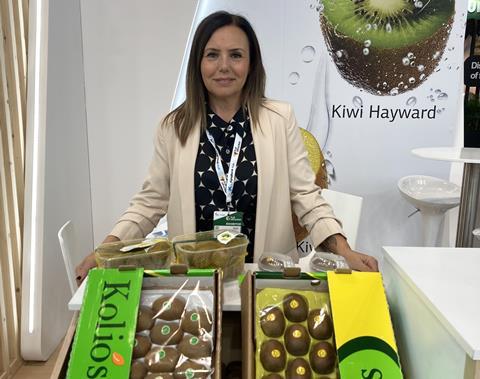Larger fruit sizes last season encouraged Greek suppliers to focus more on markets outside Europe, with North and South America increasingly a target
Last season’s exceptionally large kiwifruit sizes posed an issue for Greek exporters focused on the European market, with retailers across the continent generally favouring smaller fruit. For Youphoria Fruits, a company in its first year of exports, a decision was made early in the season to focus its attention across the Atlantic.
“We decided to work more with the US and Canada,” says general manager George Kallitsis, “where they take all sizes of kiwifruit. This year, we have all sizes in Greece so we are able to supply a good spread to many markets.

“We are looking again at Canada, the US, Brazil, Argentina, also Europe, mostly the UK, Spain, Poland, Germany, and then there is the Middle East, but it is affected a lot by logistical issues. Asian countries like South Korea have shown interest in our kiwifruit, but transit times are a bit of a problem at the moment, maybe only early in the season when the fruit is strongest.”
Kallitsis expects volumes to be similar to last year, which was slightly down on the average. Harvesting starts in mid-October, continuing until mid-November.
“The weather now is good,” he says, “with low nighttime temperatures that help the fruit to reach a higher sugar level. We will have to wait to see the effect of the very dry, hot summer which lasted for several weeks in July and August, with very high temperatures day and night. This may affect the storability of the fruit.”
Exporter Kolios started harvesting its yellow Soreli variety earlier in October. “We are planting new orchards, including of Soreli,” says Elena Kolios. “This variety is growing, but the green will always be the leader. In our area, there are 50,000 tonnes of green, but only around 1,000-1,500 tonnes of Soreli.”
Quantities should be similar to last year, she says, but sizes should be smaller due to the summer heat. “The trees were stressed by the hot weather, so this is why we have smaller sizes,” she explains. “We don’t know exactly how the fruit will react. The shelf-life is a question mark this season.”

The company started exporting to Brazil last season, and has ambitions elsewhere in Latin America. “Latin America and the US are a target,” says Kolios. “The protocol for Mexico is also nearly ready. We also send to Asia. We don’t export much to Europe in the early part of the season, only really when we stop the long transit time destinations. This year, the big issue is that we will have to stop sending to Asia early, as it takes an extra 15 or more days to reach East Asia. 45 days-plus, that’s a long journey.”



